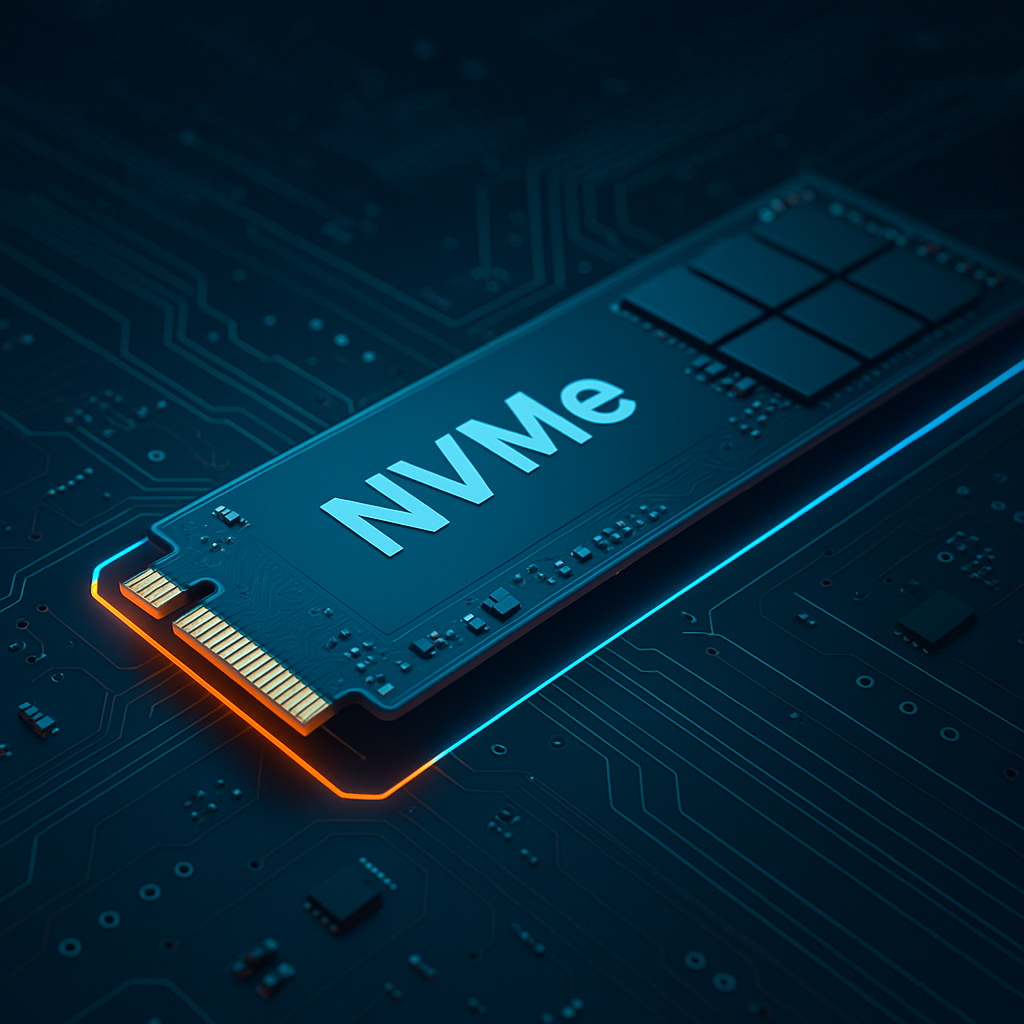- About Us
- PRODUCTS
- All Products
- Product Buyer Guide
- Internal Storage for SATA Drive
- Internal Storage for NVMe SSD
- External USB-C Storage
- HBA Card
- Converter
- Accessory
- STARDOM [ External Storage Products ]
- SUPPORT
- Knowledge
- LANGUAGE
By: RAIDONTEK Research Team
Non-Volatile Memory Express (NVMe) is a storage protocol purpose-built for solid-state drives (SSDs) over PCI Express (PCIe). By eliminating the legacy constraints of AHCI/SATA, NVMe delivers ultra-low latency, high throughput, and parallel I/O scaling, making it foundational for modern workloads such as AI, edge computing, and high-resolution media.

Storage performance remains a critical bottleneck in high-performance computing environments. Legacy interfaces like SATA—originally designed for spinning disks—cannot exploit the full capabilities of flash-based storage. NVMe addresses this limitation with an architecture optimized for solid-state and future memory technologies. By leveraging the PCIe bus, NVMe offers a direct, efficient pathway between storage and the CPU, dramatically reducing latency and maximizing throughput.
NVMe functions as both a host controller interface and a storage protocol optimized for non-volatile memory. Unlike AHCI’s single command queue of 32 commands, NVMe supports up to 64,000 queues with 64,000 commands per queue, enabling true parallelism and multithreaded I/O—well-aligned with modern multicore processors.
NVMe SSDs connect directly via PCIe lanes, bypassing legacy I/O stacks and eliminating bandwidth bottlenecks. Current PCIe generations include:
● PCIe Gen 3: ~1 GB/s per lane (≈4 GB/s with x4)
● PCIe Gen 4: Doubles throughput to ≈8 GB/s (x4)
● PCIe Gen 5: Up to ≈16 GB/s (x4)
This scaling ensures storage keeps pace with advances in CPU and GPU performance.
Key attributes that distinguish NVMe from legacy interfaces include:
● Ultra-Low Latency: Access times as low as ~10 µs (vs. ~100 µs for SATA SSDs)
● High Throughput: Millions of IOPS, ideal for intensive workloads
● Native Parallelism: Optimized for multicore, multithreaded environments
● Power Efficiency: Lower energy per I/O than AHCI-based solutions
● Flexible Form Factors: Supports M.2, U.2, EDSFF, and PCIe add-in cards
NVMe (Non-Volatile Memory Express) was designed from the ground up for SSDs, while AHCI (Advanced Host Controller Interface) was built for spinning hard drives. This fundamental difference results in a significant performance gap between the two protocols.
Comparison Table: NVMe vs. AHCI
| Feature | NVMe | AHCI |
|---|---|---|
| Protocol Origin | Designed for NAND flash and SSDs | Designed for HDDs |
| Interface Bus | PCIe (Gen3/4/5), NVMe-oF (RDMA/TCP) | SATA (Serial ATA) |
| Command Queues | 64K queues with 64K commands per queue | 1 queue with 32 commands |
| Latency | ~10–20 µs | ~100 µs or more |
| Throughput | Up to 16 GB/s with PCIe Gen5 x4 | Max 600 MB/s with SATA III |
| IOPS (Random Read/Write) | Millions of IOPS | Up to ~100K IOPS |
| CPU Overhead | Lower – optimized for parallelism | Higher – more interrupt handling per transaction |
| Power Efficiency | Better – lower power per I/O | Less efficient |
| Form Factor Flexibility | M.2, U.2, EDSFF, Add-in Cards | 2.5", 3.5" SATA drives |
| Software Stack | Modern, lean, scalable driver stack | Legacy storage stack |
| Boot Support | Fully supported by UEFI BIOS | Standard legacy and UEFI support |
| Target Use Cases | High-performance storage: AI, HPC, data centers | General-purpose computing and legacy systems |
Key Takeaway:
NVMe’s architecture eliminates SATA bottlenecks, providing the low latency and throughput essential for performance-intensive tasks.
NVMe technology is increasingly prevalent across a range of industries, each benefiting from its unique performance characteristics:
| Sector | Application Example | NVMe Benefit |
|---|---|---|
| Enterprise IT | Virtual machines, hyperconverged infrastructure | Rapid I/O for VM provisioning and workload migration |
| AI & HPC | Model training and inference | High-speed access to large training datasets |
| Media & Content | 4K/8K video editing, real-time rendering | Sustained throughput and minimal latency |
| Gaming | Game asset streaming | Reduced load times and improved responsiveness |
| Edge & IoT | Local caching, edge inference | Compact, efficient, and low-power storage solutions |
| Data Centers | NVMe over Fabrics (NVMe-oF) | High-performance networked storage infrastructure |
NVMe-oF extends NVMe capabilities over high-speed networking protocols such as RDMA (e.g., RoCE, iWARP) and TCP. This enables the deployment of disaggregated storage solutions that maintain NVMe’s performance across networked environments.
ZNS enhances efficiency by organizing data into zones, thereby reducing write amplification and increasing the longevity of SSDs. This model provides better control over how and where data is written on the device.
Emerging NVMe architectures are beginning to incorporate computational elements directly into the storage layer. By performing certain data processing tasks near the data source, CSDs reduce latency and improve efficiency, particularly in edge and AI workloads.
As PCIe evolves with Gen 5 and Gen 6 standards, NVMe’s performance potential will continue to scale. Industry adoption is accelerating across both consumer and enterprise sectors, positioning NVMe to eventually replace legacy interfaces like SATA and SAS. Meanwhile, forward-looking innovations such as NVMe over CXL and broader implementation of ZNS are expected to redefine storage paradigms for AI, cloud-native applications, and real-time edge computing.
NVMe represents a paradigm shift in storage interface design—built from the ground up to meet the demands of modern computing. By enabling high throughput, ultra-low latency, and scalable parallelism, it serves as the backbone of emerging data-intensive applications. Whether deployed in hyperscale data centers, edge computing nodes, or high-performance AI pipelines, NVMe delivers the performance and efficiency required for the next generation of digital infrastructure.
| Return |
RaidonTek.com (raidon.com.tw) uses cookies to improve site functionality and your overall experience by storing necessary information for service delivery. By continuing, you consent to our use of cookies as detailed in our Privacy Policy, which provides more information about this usage. (Accept cookies to continue browsing the website)